by Kimberly Lerch | Published: July 15, 2020
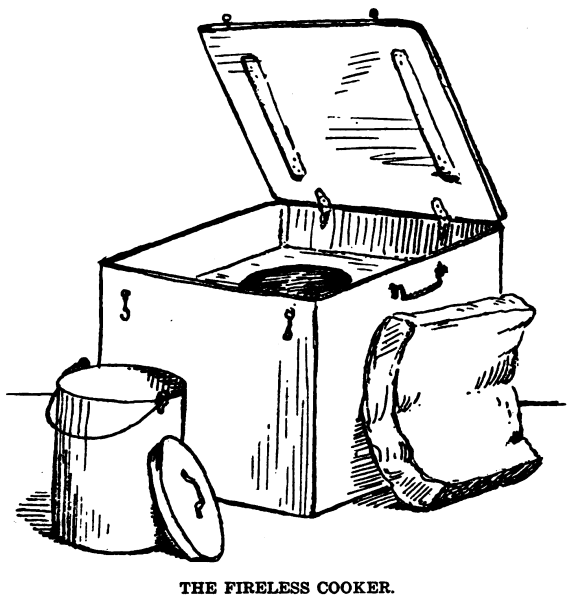
We left off on the last blog post just about ready to get some food into the hay stove. Let’s see what we should do to prep the food!
Preparing the Food for the Hay Stove
Cereals, soups, meats, vegetables, fruits, steamed breads and even puddings could be cooked in the hay stove. The food headed for the hay stove was first brought up to a boil on the regular kitchen stove. In general, less water was used in the hay stove than for foods cooked on the stove because the moisture was sealed in by the insulated box. Different foods were boiled for different lengths of time, depending on their density (root vegetables) and toughness (cheaper cuts of meat).
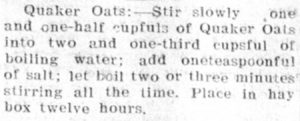
If you wanted oatmeal for breakfast, you had to prep for it the night before. Oatmeal would be cooked for two to three minutes, placed in the hay stove overnight and reheated in the morning. The recipe to the right is from the Atlas Home Department column of the Republican-Atlas from August 30, 1906[1] for Quaker Oats! There are more hay stove recipes in that column. Chapter 9 of The Fireless Cook Book is dedicated to preparing cereals in the hay box.
Meats and meat-based soups would take about 30 minutes boiling and then as long as you could leave in the hay stove (the longer it sat, the more tender it would become). Chapter 10 of The Fireless Cook Book is dedicated to preparing soups in the hay box.
Less-dense vegetables (for example, cauliflower or green beans) would only need to boil for a couple of minutes on the stove and spend a few hours in the hay stove. Sometimes those vegetables were added later in the process to a pot with root vegetables or meat. If this was done, the contents of the food container were taken out, reheated on the stove back to boiling, the new vegetables added, and then the food container was replaced in the hay stove.
Other, more dense vegetables, such as the root vegetables, such as carrots or potatoes, would need to be boiled 6-8 minutes and need about 6 hours in the hay stove to be cooked through. Vegetable soups would follow the instructions for its most dense vegetable.
Presoaked and drained rice, beans, and lentils would need between 2-10 minutes boiling and then another 4-5 hours in the hay stove.
Cabbage could go in the hay stove as soon as its water came to a boil,[2] avoiding the stench of boiled cabbage in a hot kitchen. That right there would be worth the cost of the hay stove to me!
Potential Problems with the Hay Stove
From a food safety point of view, there are two distinct disadvantages of using the hay stove: the potential of mold growth in the hay stove itself and temperature control.
If the insulation (hay, felt, paper, ground cork, wood shavings) gets wet, it can get moldy. This is easily avoidable. Always have fresh insulation material on hand. Check the hay stove for moisture/moldiness before using it or remove the insulation after each use and let the hay stove air out between usages; problem solved.
I consider temperature control to be the most concerning disadvantage. Insulation can be swapped out and eyeballing the food would most likely mean the need to reheat the food on the stove before reloading it into the hay stove, but having the food go out of the safe zone (< 140 degrees Fahrenheit) and not knowing when or how long it has been out of the safe zone is a problem. But even in 1914 they had a method for checking the food temperatures without lifting the lid. In the section entitled, “Temperature Inside the Cooking Box” in Illustrated Lecture on the Home-made Fireless Cooker[3] the authors explain how. A kettle of boiling water with a thermometer in it is placed in the hay stove with the food. The food prepared would always be denser than water (from broth to a root vegetable), so whatever the water’s temperature read, the food would be at least that temperature, if not higher.[4]
Recipes
The recipes that exist or could be converted to a hay-box recipe are endless, but let’s consider a few representative recipes that were enjoyed by the farmer’s wife and her hungry family or guests.
Vegetable Soup for Hay Stove[5]
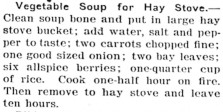
These old recipes leave a lot of leeway for interpretation. I’m thinking vegetable soups could include any readily available vegetables your garden or trip to the store may supply (potatoes, peas, green beans, tomatoes, etc.). Just rice, carrots, and onions spiced up with some salt, pepper, bay leaves, allspice and a hint of bone broth doesn’t sound all that appetizing.
Beef Loaf[6]
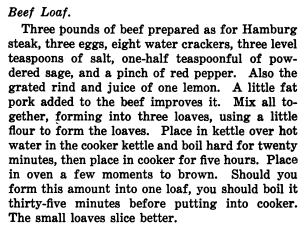
A three-pound meatloaf! Either this farmer’s wife had a large family, was feeding guests or farm hands, or was expecting the family to eat meatloaf sandwich leftovers. An interesting way of initially heating the meat is used for this meat product—the double boiler. The meatloaf itself was not boiled; it was placed above boiling water and heated to the desired temperature. As with steamed breads, the food was to be moist, but the ‘crust’ should be crispy, so a short stint in the regular oven at the end of hay stove cooking was required.
Turkish Pilaf[7]
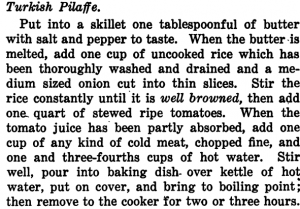
This recipe contains a finely chopped meat and a vegetable that can be cooked until it loses its form (say, broccoli). The length of time to cook depends on the rice in the dish; the tomatoes and the meat will be thoroughly cooked by the time the rice is ready.
The Original Slow Cooker
We’re not so different from the farmer’s wives from a century ago. We still want what they wanted from their kitchen appliances. As Mrs. Woodward, Mrs. Riedinger, and Mrs. Redfield noted in a 1907 issue of Ohio Farmer, the hay stove:
- Saved fuel
- Cooked tender, tasty food—meat is more tender, and meats, vegetables, and water with seasoning creates its own tasty broth or gravy
- Could be left without the worry about burning the house down
- Involved easy cleanup of pots and pans (no scorching, burning, or sticking)
- Saved time (no time wasted stirring)
- Didn’t stink up the kitchen (cabbage, I’m looking at you)
- Made food ready when family members wanted to eat at different times.[8]
Put more succinctly: “The advantages claimed for the fireless cooker are economy of fuel, convenience and economy of time.”[9]
The hay stove was the original ‘slow cooker.’ I have two crock pots. One is HUGE; I can make up huge batches of soup (vegetable, potato, chili) to freeze for future meals. One is not quite so large; it’s great to cook up Italian beef or other tough cuts of beef in—the slow cooking for hours really tenderizes the meat— “fork-tender.” The broths, au jus, gravies, drippins’—whatever you want to call them just get better as all the flavors intermingle for hours. If I had been a farmer’s wife back in the early 1900s, I absolutely would have insisted on having a hay stove in my kitchen!
Help with Text Correction
The newspapers in the Illinois Digital Newspaper Collections are searchable because of computer-generated text that underlies the page images. This computer-generated text is far from perfect! You can help improve the accuracy of keyword searches by correcting errors. Thanks to the hard work of volunteer text correctors, more than a million lines of text have been corrected so far.
Register to become a text corrector.
Learn more about how to help correct newspaper text.
Notes:
[1] “Atlas Home Department: Hay Stove Recipes,” Republican-Atlas, August 30, 1906, https://idnc.library.illinois.edu/?a=tc&d=TRA19060830.1.3&e=——-en-20–1–img-txIN———.
[2] “In the Dairy: The Hay Stove.” Farmer’s Wife, November 1, 1906, https://idnc.library.illinois.edu/?a=d&d=FFW19061101.2.55&e=——-en-20–1–img-txIN———.
[3] Davis, K.C. and Wood, Angeline, Illustrated Lecture on the Home-made Fireless Cooker, (Washington, DC, 1914), https://babel.hathitrust.org/cgi/pt?id=mdp.39015073293337&view=1up&seq=298.
[4] Ibid.
[5] “Table Delicacies: Vegetable Soup for Hay Stove.” Bureau County Tribune, August 2, 1907, https://idnc.library.illinois.edu/?a=d&d=BCT19070802.1.11&e=——-en-20–1–img-txIN———.
[6] Lovewell, Whittemore and Lyon, The Fireless Cooker, (Topeka, KS, 1908), https://catalog.hathitrust.org/Record/008684751.
[7] Ibid.
[8] Woodward, H.M., Riedinger, Laura Rhoades, and Redfield, S.P.. “Household Department.” Ohio Farmer, July 6, 1907, https://idnc.library.illinois.edu/?a=d&d=OFR19070706.2.35&e=——-en-20–1–img-txIN———.
[9] Wikisource. “The Encyclopedia Americana (1920)/Fireless cooker.” Wikisource. Last modified October 21, 2010. https://en.wikisource.org/wiki/The_Encyclopedia_Americana_(1920)/Fireless_cooker.